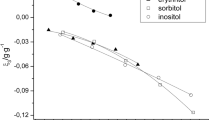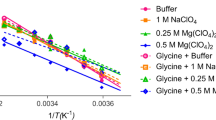Abstract
Osmolytes are cosolutes that induce stabilization of the structure of proteins. Polyols are osmolytes that have importance in a wide variety of biotechnological and industrial processes. In this work, a systematic study concerning the effect of polyols of different number of methylene and hydroxyl groups on the stability of α-chymotrypsinogen A is presented. Protein thermal stability measurements in buffer, ethylene glycol, glycerol, meso-erythritol, sorbitol and inositol was followed by fluorescence measurements. Under the selected conditions, the thermal denaturation of α-chymotrypsinogen A is a reversible transition between native and unfolded state that can be well described by a two-state model. Reversibility of the transition was confirmed by DSC, circular dichroism, UV–Vis and fluorescence measurements. The change in thermal stability of the protein in the presence of ethylene glycol, glycerol, erythritol, sorbitol and inositol shows that ethylene glycol is the only polyol that presents a destabilizing effect. The other cosolutes exert stabilizing effects that increase with the number of hydroxyl groups and depend on concentration.









Similar content being viewed by others
References
Romero CM, Lozano JM, Sancho J, Giraldo GI. Thermal stability of beta-lactoglobulin in the presence of aqueous solution of alcohols and polyols. Int J Biol Macromol. 2007;40:423–8.
Xie G, Timasheff S. Mechanism of the stabilization of ribonuclease A by sorbitol: preferential hydration is greater for the denatured than for the native protein. Protein Sci. 1997;6:211–21.
Davis-Searles PR, Saunders AJ, Erie DA, Winzor DJ, Pielak GJ. Interpreting the effects of small uncharged solutes on protein-folding equilibria. Annu Rev Biophys Biomol Struct. 2001;30:271–306.
Kaushik JK, Bhat R. Thermal stability of proteins in aqueous polyol solutions: role of the surface tension of water in the stabilizing effect of polyols. J Phys Chem. 1998;102:7058–66.
Gerlsma S. The effects of polyhydric and monohydric alcohols on the heat induced reversible denaturation of chymotrypsinogen A. Eur J Biochem. 1970;14:150–3.
Xie G, Timasheff SN. The thermodynamic mechanism of protein stabilization by trehalose. Biophys Chem. 1997;64:25–43.
Theodore BG, Herskovits T. On the structural stability and solvent denaturation of proteins. J Biol Chem. 1970;245:2588–98.
Hartley BS. Amino-acid sequence of bovine chymotrypsinogen-A. Nature. 1964;201:1284–7.
Brandts JF. The thermodynamics of protein denaturation i. the denaturation of chymotrypsinogen. J Am Chem Soc. 1964;86:4291–301.
Brandts JF. The thermodynamics of protein denaturation II. A model of reversible denaturation and interpretations regarding the stability of chymotrypsinogen. J Am Chem Soc. 1964;86:4302–14.
Jackson WM, Brandts JF. Thermodynamics of protein denaturation. Calorimetric study of the reversible denaturation of chymotrypsinogen and conclusions regarding the accuracy of the two-state approximation. Biochemistry. 1970;9:2294–301.
Poklar N, Vesnaver G, Lapanje S. Interactions of alpha-chymotrypsinogen A with alkylureas. Biophys Chem. 1996;57:279–89.
Chalikian TV, Volker J, Anafi D, Breslauer KJ. The native and the heat-induced denatured states of α-chymotrypsinogen A: thermodynamic and spectroscopic studies. J Mol Biol. 1997;274:237–52.
Romero CM, Albis A, Lozano JM, Sancho J. Thermodynamic study of the influence of polyols and glucose on the thermal stability of holo-bovine α-lactalbumin. J Therm Anal Calorim. 2009;98:165–71.
Cooper A. Thermodynamics of protein folding and stability. Protein A Compr Treatise. 1999;2:217–70.
Brandts JF, Hunt L. Thermodynamics of protein denaturation III. Denaturation of ribonuclease in water and in aqueous urea and aqueous ethanol mixtures. J Am Chem Soc. 1967;89:4826–38.
Haque I, Singh R, Moosavi-Movahedi AA, Ahmad F. Effect of polyol osmolytes on ∆GD, the Gibbs energy of stabilisation of proteins at different pH values. Biophys Chem. 2005;117:1–12.
Sancho J. The stability of 2-state, 3-state and more-state proteins from simple spectroscopic techniques… plus the structure of the equilibrium intermediates at the same time. Arch Biochem Biophys. 2013;531:4–13.
Miyawaki O, Tatsuno M. Thermodynamic analysis of alcohol effect on thermal stability of proteins. J Biosci Bioeng. 2011;111:198–203.
Gekko K, Morikawa T. Thermodynamics of polyol-induced thermal stabilization of chymotrypsinogen. J Biochem. 1981;90:51–60.
Privalov PL. Stability of proteins: small globular proteins. Adv Protein Chem. 1979;33:167–241.
Sturtevant JM. Biochemical applications of differential scanning calorimetry. Annu Rev Phys Chem. 1987;38:463–88.
Privalov PL, Khechinashvili NN. A thermodynamic approach to the problem of stabilization of globular protein structure: a calorimetric study. J Mol Biol. 1974;86:665–84.
Greenfield NJ. Using circular dichroism spectra to estimate protein secondary structure. Nat Protoc. 2006;1:2876–90.
Greenfield NJ, Fasman GD. Computed circular dichroism spectra for the evaluation of protein conformation. Biochemistry. 1969;8:4108–16.
Brahms S, Brahms J. Determination of protein secondary structure in solution by vacuum ultraviolet circular dichroism. J Mol Biol. 1980;138:149–78.
Reed J, Reed TA. A set of constructed type spectra for the practical estimation of peptide secondary structure from circular dichroism. Anal Biochem. 1997;254:36–40.
Mao D, Wachter E, Wallace BA. Folding of the mitochondrial proton adenosine triphosphatase proteolipid channel in phospholipid vesicles. Biochemistry. 1982;21:4960–8.
Freer ST, Kraut J, Robertus JD, Wright HT. Chymotrypsinogen: 2,5-Å crystal structure, comparison with α-chymotrypsin, and implications for zymogen activation. Biochemistry. 1970;9:1997–2009.
Wang D, Bode W, Huber R. Bovine chymotrypsinogen A X-ray crystal structure analysis and refinement of a new crystal form at 1.8 A resolution. J Mol Biol. 1985;185:595–624.
Khan F, Khan RH, Muzammil S. Alcohol-induced versus anion-induced states of alpha-chymotrypsinogen A at low pH. Biochim Biophys Acta. 2000;1481:229–36.
Acknowledgements
This work was supported by Universidad Nacional de Colombia and COLCIENCIAS and by Grants BFU2010-16297, BFU2010-19451, PI078/08 and CTPR02/09 (Spain).
Author information
Authors and Affiliations
Corresponding author
Rights and permissions
About this article
Cite this article
Romero, C.M., Abella, J.S., Velázquez, A. et al. Thermal denaturation of α-chymotrypsinogen A in presence of polyols at pH 2.0 and pH 3.0. J Therm Anal Calorim 120, 489–499 (2015). https://doi.org/10.1007/s10973-014-4374-2
Received:
Accepted:
Published:
Issue Date:
DOI: https://doi.org/10.1007/s10973-014-4374-2




